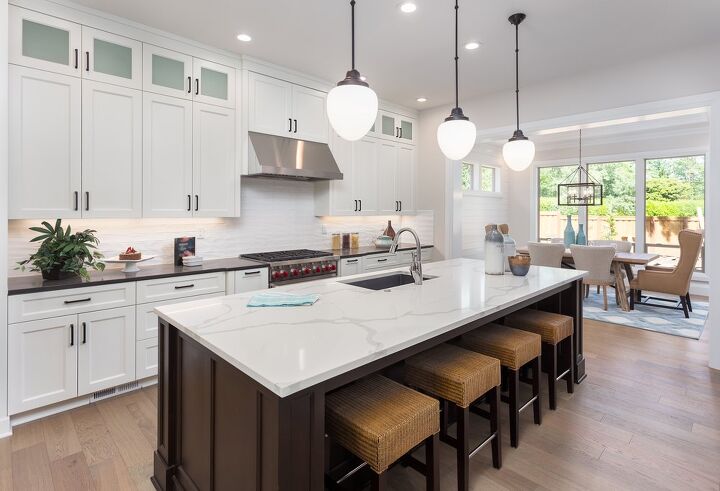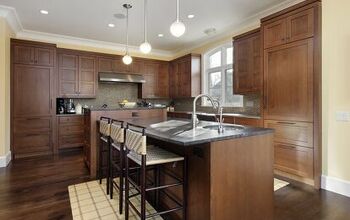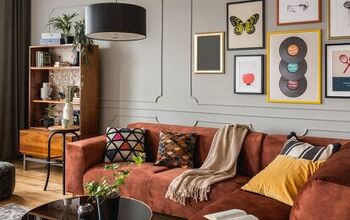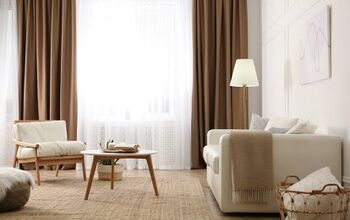What Color Countertops Go With Brown Cabinets?

Finding the right color of countertops to go with brown cabinets can seem tricky, but it’s not. You can accomplish this by combining color matching basics and personal taste. With these, and a few other factors, finding which countertops go with brown cabinets isn’t tricky at all.
Light colors like white and cream countertops with brown cabinets create an open space feel. Using neutral color countertops, like tan, beige, and medium gray with brown cabinets, will give you a more traditional look. Use darker colors, like black marble, green, or blue countertops with your brown cabinets if you want a more dramatic effect.
Installing countertops can be a large investment, with money and time, and is the main focal point of the space. That’s why it is important to find the countertop color that coordinates with your kitchen for years to come. Below you’ll learn how different countertop colors and materials complement your brown cabinets.
Do You Need Countertop Installers?
Get free, zero-commitment quotes from pro contractors near you.

What Color Countertops Go With Brown Cabinets?
When picking out what color countertops to go with your brown cabinets, the determining factor is your personal style. Do you like spaces to feel open and bright, or do you prefer something more dramatic? When picking a color of countertops to go with brown cabinets, the first step is identifying the undertones of brown.
Are your cabinets a warm light brown that showcases the natural wood? A rich espresso brown or a reddish cherry, perhaps. Identifying the shade of brown will help narrow down your choices and streamline the design process.
For medium brown cabinets, gray can help lighten the tone of the room. Brown cabinets with natural undertones like gold, yellow, or beige pair well with warm tones, like orangish-gold. Green or blue granite creates a stark and complementary contrast for medium orange-brown cabinets.
1. Light Color Countertops Go With Brown Cabinets
- White
- Cream
- Tan
- Beige
Light color countertops are a classic pairing for brown cabinets and other darker shades. The stark contrast opens up the space and gives your kitchen a transitional aesthetic. The combination of white quartzite countertops and dark brown cabinets provides the space with a sleek, modern look.
If a traditional style that feels open is the vibe you want, lighter shades are the way to go. In a process that can feel overwhelming, choosing light-colored countertops to go with brown cabinets is a safe bet.
2. Dark Color Countertops Go With Brown Cabinets
- Dark Natural Stone
- Gray With Warm Undertones
- Dark Green
- Dark Blues
- Black Marble With Light Veining
Darker colors may seem like a strange choice to go with brown cabinets, but this can produce some stunning results. If your personal style leans towards the dramatic, then pairing dark countertops with brown cabinets is the way to go. For example, dark-hued natural stone or black marble with light veining.
The darker-colored countertops with brown cabinets can give the space an expensive and dramatic feel. The space can also feel cozy and welcoming as well as sleek and modern.
3. Gray Countertops Go With Brown Cabinets
This may seem like an odd combination, but when properly planned can have great results. Gray countertops with brown cabinets give everything a neutral tone, especially if your cabinets are a darker shade of brown. If you’re concerned, choose a gray countertop with flecks of colors that match the cabinets to tie them together.
Since brown is such a warm color, try to find a gray that has warm undertones. This will help tie the normally contrasting colors together. Painting the walls gray can also help tie the two colors together and make the cabinets the focal point.
Granite, Marble, Quartz, And Laminate Countertops
You’ve picked the color countertops to go with your brown cabinets; now, what material to use? Kitchen countertops not only need to look good but need to be durable as well. Let’s explore four popular options, granite, marble, quartz, and laminate.
Granite
Unlike most countertop materials, granite is 100% natural and very durable. Granite consists of natural stone from stone quarries, that is cut into slabs, polished, and fabricated into countertops. However, they are not quarried slabs but rather a mix of stone byproducts formed into slabs for countertops.
The downside of granite is that it is a porous surface, and you need to reseal it on a yearly basis. If not maintained, oils, juice, and wine can seep in and stain the countertop and are nearly impossible to remove. Granite that is not properly sealed can also harbor bacteria.
Marble
Marble countertops give any space an air of opulence, and like granite, they are a beautiful natural material. Cultured marble is made of a blend of stone particles and resins to produce natural-looking patterns and colors. It is important to keep in mind marble is not as durable as granite and can be prone to chipping.
Quartz
Surprisingly quartz countertops are not slabs of pure quartz. More like engineered stone, quartz countertops consist of leftover crushed granite, marble, and other natural stone. Some also feature recycled industrial waste like ceramics, glass, and mirrors.
In recent years, quartz countertops have become slightly more popular than granite. Due to the fact that, compared to granite, it is harder, less porous, and nearly indestructible. These features make it easier to maintain than granite or marble.
Laminate
The most affordable of the four, laminate designs can mimic the colors and styles of marble and granite. They are low maintenance and inexpensive, which explains why it is so widely used. But cheap does not mean poor quality; many high-end homes have laminate countertops.
Laminate is a great option if you want to try your hand at DIY and install the countertops yourself. Laminate is also widely available and easy to find. A few cons about laminate are it is not heat resistant, scratches easily, and is prone to peeling.
Are Brown Cabinets Outdated?
The simple answer is no. Brown cabinets have been a kitchen staple since the 1900s, making some wonder if brown cabinets are outdated. However, earthy tones with a more organic style is the latest trend in home design.
In fact, in 2021, coffee-stained wood tones gained popularity. If your brown cabinets are in need of a modernized look, coordinating with the countertops is one solution. Here are some suggestions for updating your brown cabinets.
Changing the hardware by swapping knobs to bars goes a long way in creating a different feel and style. A slightly more expensive change can be upgrading your appliances to stainless steel. Upgrading to more modern light fixtures, like pendant lighting, will drastically change the vibe and complement your brown cabinets.
Do You Need Countertop Installers?
Get free, zero-commitment quotes from pro contractors near you.

Related Questions
How do I choose a countertop color?
When picking a countertop color, it makes sense to match the current color scheme of the room. However, keep in mind that your tastes may change, and what worked before could look outdated. To avoid this, pick out something with flecks or veins of your favorite color to keep options open.Unlike paint, countertop samples typically are large, and you need to make your decisions at the store. There are usually samples of wood and paint colors to help with your selection. To get a better idea, place the samples in the correct orientation (paint and cabinets vertical, floor and countertops horizontally).Having lighter countertops creates a focal point and gives the kitchen a clean and open look. Many have designs that can help complement the existing color scheme of the space. Dark countertops will look more sleek and modern with darker tones and patterns.Essentially there are no right or wrong colors for countertops; it all comes down to the aesthetic and feel you want to achieve.
What colors go with a brown kitchen?
Traditionally, white is a great option, especially with dark browns. If a pop of color is what you’re looking for, blue gives a great modern feel. Other colors to consider are fuchsia, gold, orange, mint, turquoise, and yellow.When selecting colors for your kitchen start with ones that you love, then narrow down your options based on how you want your kitchen to feel. Select several complementary colors to your existing browns, and purchase some paint samples. You can use the paint cards that come from the store, but using the actual paint is much more effective.You can purchase a sample jar for about $4. Use it to paint a large swatch on the wall.If you don’t want to paint the wall, paint large pieces of poster board and hang them up. Make sure to observe how the colors change under different light.
How can you brighten up a dark kitchen?
If there is a concern that darker cabinets with darker countertops will make your kitchen too dark, then try adding lighter elements elsewhere. Making the walls, backsplash, and floors a lighter shade can help balance the dark countertops and brown cabinets. Additionally, highly reflective surfaces, regardless of color, can help make the space feel larger.Light is key in opening a space, so having a big window to let natural light in can be beneficial. Under-cabinet LED lighting will illuminate dark spaces and are cheap and easy to install or switch to brighter light bulbs. If the space needs to feel bigger, the old stand-by is to hang up some mirrors in your kitchen. Adding pops of color or light-colored accents can help balance the darker hues and create contrast.

Stacy Randall is a wife, mother, and freelance writer from NOLA that has always had a love for DIY projects, home organization, and making spaces beautiful. Together with her husband, she has been spending the last several years lovingly renovating her grandparent's former home, making it their own and learning a lot about life along the way.
More by Stacy Randall



























